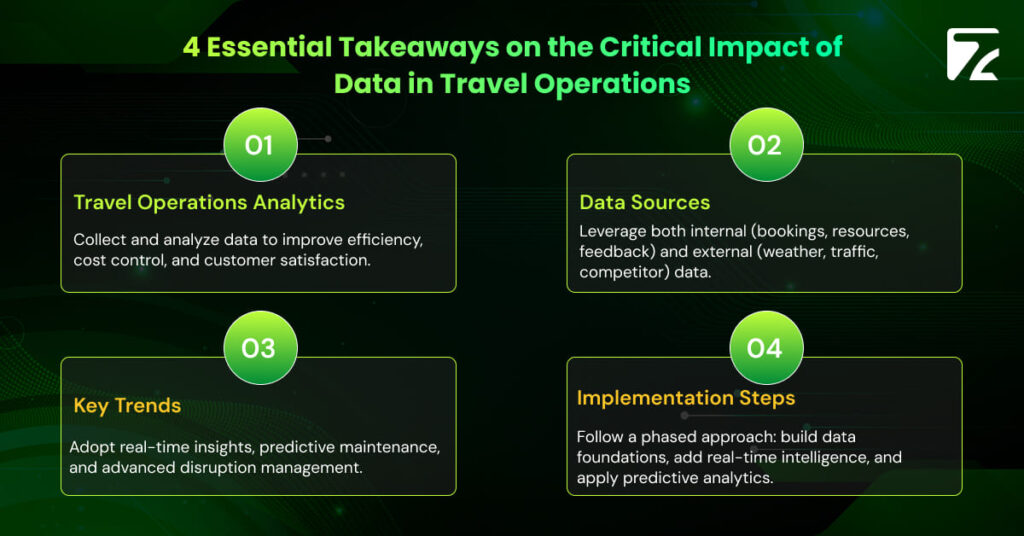Today’s modern travel industry is utilizing data in innovative ways to automate decision-making processes. Travel analytics does not merely stop at improving customer experience; it affects operational efficiency, revenue, and business edge in the market. This article examines various sources of data and how they can be implemented in travel operations, taking into consideration their value to business.
Travel operations analytics is the collection and analysis of data concerning the operations of a travel business, including resource allocation, disruption management, service provision, and operational cost control. Accounts for different forms of analysis includes the following:
Descriptive analytics: Review of past data on the business’s operational success.
Diagnostic analytics: Looking for the why underlying an operational failure.
Predictive analytics: Looking forward to possible operational headaches.
Prescriptive analytics: Proposing certain operational measures to be taken.
In the case of travel companies, a recent study has shown that implementation of a complex analytic approach led to a reduction in operational costs by 10-20% and an increase in client satisfaction by up to 25%.
Dynamics of successful travel operations analytics Getting outstanding travel operations analytics off the ground requires rich, varied data from internal and external sources.
Internal data is the intellectual property of a company, built upon the day to day business activities:
Booking and reservation information: Trend, quantity, time lag, and cancellations
Resource Use Measures: Productivity of staff, utilization of equipment, and occupancy of the facility
Performance metrics of service delivery: On-time rates, service completion rates, and quality scores
Cost information: Operational costs, by category (personnel, site, equipment, etc.)
Voice Of The Customer Records feedback: service-related complaints, satisfaction scores, reviews
For example, a European airline captures more than 10 terabytes of operational data per month, ranging from aircraft movement to crew assignment to passenger flow
External data is data generated outside the organization:
Airlines, for example, assimilate high-resolution weather field information into their operations in order to forecast potential disruptions and to optimize flight routing

As opposed to historical views of business as traditional business intelligence does, real-time analytics enables instant operational insights and action.
One example we’ve seen: A leading hotel chain built a dynamic, real time dashboard that combines room cleaning status alongside maintenance issues, check-in/checkout patterns and staffing levels. The response time of operational incidents was decreased by 62% while the efficiency of resource allocation was increased by 28% in the system.
Main aspects of real-time operational intelligence are as follows:
Travel is especially prone to being thrown off course by weather, mechanical hiccups, labor shortages, and any number of other random factors. With their advanced analytics capabilities, performance visibility systems are well-placed to respond and rebound quickly.
Real-World Use Case: SAS (Scandinavian Airlines) worked with Amadeus to deploy a next-gen revenue management solution, with RLM integrated with real-time disruption management. This system:
Results included a 30% enhancement in predicted demand, heightened disrupt management and maximisation of revenues during disruption times.
Using IoT sensors placed on the equipment, along with machine learning algorithms, predictive maintenance structures and optimizes maintenance schedules while preventing disruptions from removing activities that are meant to be done during operations.
Industry Example: An advanced predictive maintenance system that transforms operational safety and efficiency was developed by Southwest Airlines in collaboration with NASA. This system:
This collaboration resulted in an automated system that processes enormous amounts of data designed to prevent accidents and optimize maintenance operations all while significantly cutting costs and enhancing safety metrics.
A growing number of travel oriented companies apply predictive maintenance to various assets as follows:
Analytics gives travel businesses the opportunity to save costs by analyzing:
Case study outcomes: Automated dynamic pricing that Marriott International implemented dramatically improved their operational cost management. Their Revenue Optimization System (ROS) assesses a multitude of data to determine pricing and operational resource allocation. With this system, Marriott achieved:
The structured operational change allowed the company to fundamentally alter the way revenue was being registered, thereby enhancing resource and operational resource allocation throughout cross-functional teams and across company portfolios.
Travel operations data is often scattered across multiple systems that don’t talk to each other well:
Solution Approach: Smart travel companies are now using data virtualization platforms that pull information from different systems without physically moving all the data to one place. This gives them a complete view of operations without massive, complicated data migration projects.
Operational data often comes with quality problems:
Implementation Strategy: Companies that get this right use automated quality monitoring that constantly checks operational data for completeness, accuracy, timeliness, and consistency. One hotel management company cut booking mix-ups by 92% using this approach.
Many operational decisions can’t wait for overnight batch processing—they need insights now.
Technical Solution: Advanced travel operations platforms use technologies like Apache Kafka and Apache Flink to analyze operational data as it comes in, giving decision support in less than a second.
Based on what works best in the industry, we suggest tackling operations analytics in stages:
Start with the basics:
Expected Timeline: 3-6 months
Typical ROI: 15-25% improvement in key operational metrics
Move up to real-time capabilities:
Expected Timeline: 6-12 months after Phase 1
Typical ROI: 25-40% improvement over baseline metrics
Add advanced prediction capabilities:
Expected Timeline: 12-18 months after Phase 2
Typical ROI: 40-60% improvement over baseline metrics
Several exciting technologies are changing how travel operations work:
Digital twins create virtual copies of your physical operations, letting you test and optimize changes before making them in real life.
Application Example: One major airport is building a digital twin that models everything from passenger flow to baggage handling. They can test new procedures virtually first, cutting risk and finding the best approaches.
Advanced ML models can juggle hundreds of variables to suggest the best operational decisions calculations that would overwhelm any human.
Implementation Case: An airline’s control center now uses an ML platform that recommends how to recover from disruptions based on past patterns and current conditions. It evaluates thousands of possible solutions in seconds, finding the sweet spot between costs and passenger impact.
Computer vision lets you automatically monitor physical spaces and processes without having staff constantly watching.
Real-World Application: A cruise line installed computer vision systems that watch passenger flow in common areas, automatically spotting unusual crowding and alerting staff to open more service points or redirect traffic.
Despite all this tech, people remain crucial in travel operations. The best setups combine precise algorithms with human judgment and experience.
Balanced Approach: Leading travel companies create clear frameworks for how humans and machines work together:
A major Asian airline shows how this works well. Their disruption management system creates optimized recovery plans, but humans make the final calls, considering factors the algorithm can’t fully grasp like VIP passengers, cultural considerations, or strategic partnership impacts.
Here are several proven implementations showcasing how data-driven approaches are transforming travel operations:
American Airlines rolled out an intelligent gating program that changed their airport operations through real-time analytics.
Implementation Details:
Measurable Results:
Hilton Hotels & Resorts implemented data analytics to transform their decision-making and make guests happier.
Implementation Details:
Measurable Results:
Operations analytics has shifted from being an advantage to the travel industry’s need, as a result of sustaining modernization. Organizations that embrace data-driven practices are not just cutting costs and improving efficiency, but are accomplishing a foundational change in the effortless experience they provide travelers.
Data-driven operations with fully integrated artificial intelligence technologies offer a powerful competitive edge. Spending on logical planning tools for anticipating journeys pays off within one trip. For other branches of travel, such as hotels and restaurants, mounting custom based order management systems improves service speed and accuracy to clients, fulfilling modern demands and international standards. In the course of optimization tasks of travel companies, travel operation systems will remain the most important factor for achieving strategic objectives.
The prerequisites of application include a paradigm shift and sovereignty over not only operational tools, but conceptual ones. Gaining full access to an enabler for sustained international business mobility and enhancing corporate performance vehicle needs a modification in strategic objectives towards attaining an advanced integrated approach that broadened technological systems focus on integration with adaptable environments. Collapse and resource optimization comes into play when implemented with prospective client mobility needs. Every travel company that wants to stay afloat amidst contemporary paradigm shifts will need to keep in pace with modern technological expansion.
With the emphasis companies put today on gaining customer loyalty with the help of operational flexibility along with digital planning encompass the dependency of business on technological standards through enabling advanced self-optimization capabilities at international mobility sustains international cross-business enterprise integration modernization unparalleled by previous decades.
Data-driven operations can bolster these efforts significantly. With such continuously perceived operational advancement synergy, traditional aerial transportation providers and new entrants from the tech industry gain instantaneous mobility to compete equally anywhere on the globe with the means required to embrace wide scale digital enhancement initiatives.
Travel operations analytics involves collecting and analyzing data related to travel business operations, such as resource allocation, disruption management, service delivery, and cost control. This analysis helps in making informed decisions to enhance efficiency and customer satisfaction.
Data analytics enables travel companies to optimize operations, improve customer experiences, forecast demand, manage disruptions, and reduce operational costs by providing actionable insights derived from various data sources.
External data sources encompass weather forecasts, traffic and transit information, competitor benchmarks, economic indicators, and social media reviews.
Higher CSAT boosts repeat bookings and client retention, leading to stronger long-term profitability.

Travel Automation Expert